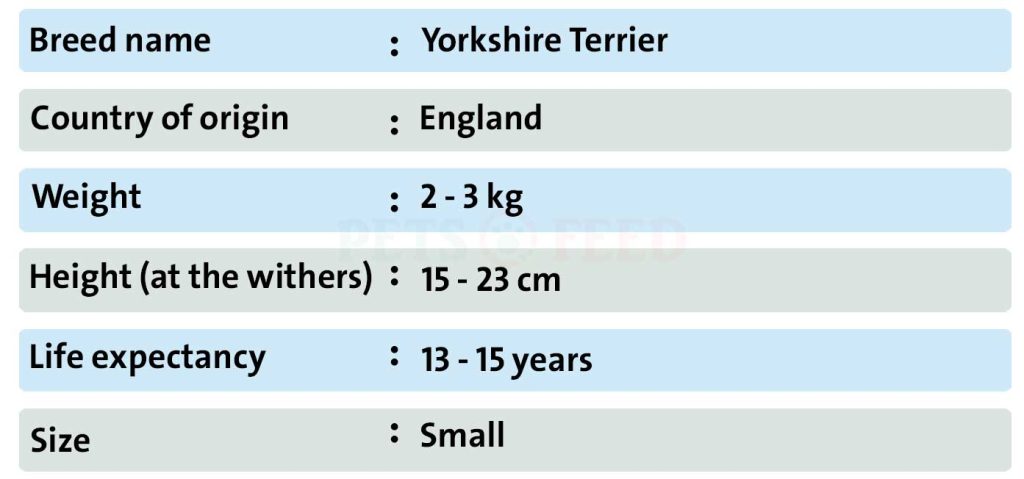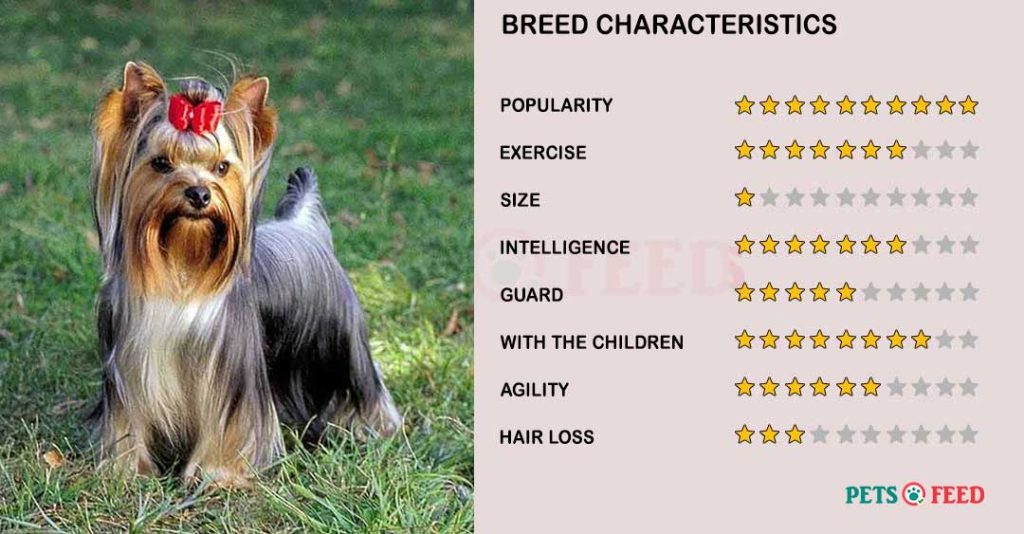If you want to have a toy dog in your house, which, despite its small size, has the character of a fearless hunter, be sure to get yourself a Yorkshire terrier. Representatives of this English breed seem to really look like a soft toy, but in fact they are real terriers.
The Yorkshire terrier is a small dog. If you are thinking of adopting one, it is very important that you first investigate the character and other related factors of a Yorkshire Terrier.

Yorkshire Terrier photos
[foogallery id=”44004″]
Physical characteristics
The Yorkshire terrier is a miniature dog and quite strong and corpulent. Its height from the ground to the withers is 15-23 cm, and its standard weight is 2-3 kg (no more than 3 kg for show specimens).

Distinctive features
- Head: Small with a flat top. Nostrils open. The muzzle is slightly elongated.
- Jaws: Strong despite its small size. With a scissor bite.
- Ears: Standing triangular with fringes. Located at a medium distance.
- Eyes: Expressive, touching by their marionette, their sincerity and their ingenuity. Hazelnut iris.
- Torso: Harmoniously folded, all parts are proportional, the back is equal, relatively short. The posture is touching, proud and elegant.
- Legs: Slender, straight. Elbows and joints do not protrude. Move vigorously and gracefully at the same time.
- Coat: Not wavy and silky. No undercoat. The structure is similar to that of human hair, it grows continuously, starting from the nose. The color is black or all variations of brown, tan, ashen with dark or red fire markings on the muzzle, chest, legs. Rarely found red-gold tan.
Character and behavior
The Yorkshire Terrier is a very gentle and good-natured animal, whose vocation is to be an ideal companion for every person. They are sweet, very open and like little children who live in a carefree world.
Sometimes you may come across a Yorkshire terrier reacting aggressively to a stranger, barking at them or trying to grab their leg – it happens. This is usually due to a lack of education, for which the dog owners themselves are responsible, although one cannot ignore heredity, on which sometimes a lot depends.
They love to walk, play with other dogs, they love to have fun and generally enjoy different types of activities. They are great with children, always happy to play with them. They tolerate the road and travel well, but they tolerate loneliness and separation from loved ones extremely poorly – this should be avoided if possible. In addition, the dog being very small, it is easy to take it with you on the road if you go on vacation, for example.
Despite the amiable nature, some specimens may show excessive barking or excessive flippancy towards other dogs, including large ones. Especially in the presence of the owners. This needs to be handled in the right way, otherwise barking with or without a reason can become a headache for the owner and others. On the other hand, in the circle of their favorite people, these dogs are extremely friendly and open.
They require early socialization in order to behave as harmoniously as possible in the circle of other animals and people. The Yorkshire Terrier is well suited as a first pet, although it does require some attention and care.
Health
The Yorkshire Terrier breed can have health problems related to, among other things, genetic diseases. Among them :
- Distichiasis;
- Lack of formation of the turn of the second cervical vertebra, which leads to damage to the spinal cord, the disease is not associated with age, symptoms begin with pain in the neck up to quadriplegia;
- Legg-Calvé-Perthes syndrome;
- Sliding kneecaps – a genetic defect inherent in the Yorkshire Terrier breed, but it can also be caused by accidental injury;
- Portosystemic shunt, congenital malformation of the portal vein;
- Tracheal collapse, caused by progressive weakening of the tracheal walls, occurs in many toy breeds, especially smaller than average Yorkies;
- Hypoglycemia.
Life expectancy
The owner, who by all the rules feeds, maintains and cares for his small pet, will be able to enjoy his healthy appearance, playful disposition and live with him for 13-15 years.
Care
The coat of the Yorkshire Terrier can become very long and therefore the specifics of the care will depend on the hairstyle you choose for your pet. Depending on the length of the coat, you will need to brush it at least once a week or more.
Always keep your pet’s ears and eyes clean and trim its claws in time. Bathe your dog about 2-3 times a month. If a pet sleeps with you in the same bed, which happens, sometimes it needs to be bathed more often.
Exercise
The Yorkshire Terrier is an energetic little dog and you need to give him the right amount of daily exercise to be a happy, healthy and well-balanced dog. A good 30-minute exercise is ideal, but being terriers, Yorkies love to run in a back garden as often as possible to really let off steam.
History of the breed
The Yorkshire Terrier first appeared in the 19th century, when it began to develop a small breed of easy-to-care terriers for rat hunting. It was not until 1860 that it was officially presented in competitions, the Yorkshire terrier that we know today and such was its popularity that swept away various competitions and exhibitions. It is thought that the Yorkshire breed may be a descendant of the English Toy Terrier, the skye terrier or the dandie dinmont tierrer among many others, that is to say that its origin is not entirely clear.
It was an easy breed to care for and educate, with very nice physical characteristics and not at all aggressive with people, but with animals, their main task. It was perfect for any type of family because at that time, it was one of the most “economical” breeds that existed.
As explained, the Yorkshire terrier has been used among the humblest classes for the elimination of rat pests. Despite its small size, it was well known that the Yorkies had killed many of these rodents without fear. They were so popular that they began to participate in various “sports” related to the rats chasing and betting at the time.
Later, it was the British bourgeois who found a sweet and handsome companion dog in the Yorkshire terrier and began to stop using it for hunting rodents. However, the history of Yorkshire as a rat hunter still accompanies it because it is not difficult to warn very alert and hunting specimens.


